Make Grocery List From Recipes: Your Complete Digital Guide
Master how to make grocery list from recipes efficiently. Transform your meal planning with proven strategies that save time and eliminate food waste.
Ready to Simplify Your Meal Planning?
Get personalized meal plans and grocery lists automatically matched to your macro targets.
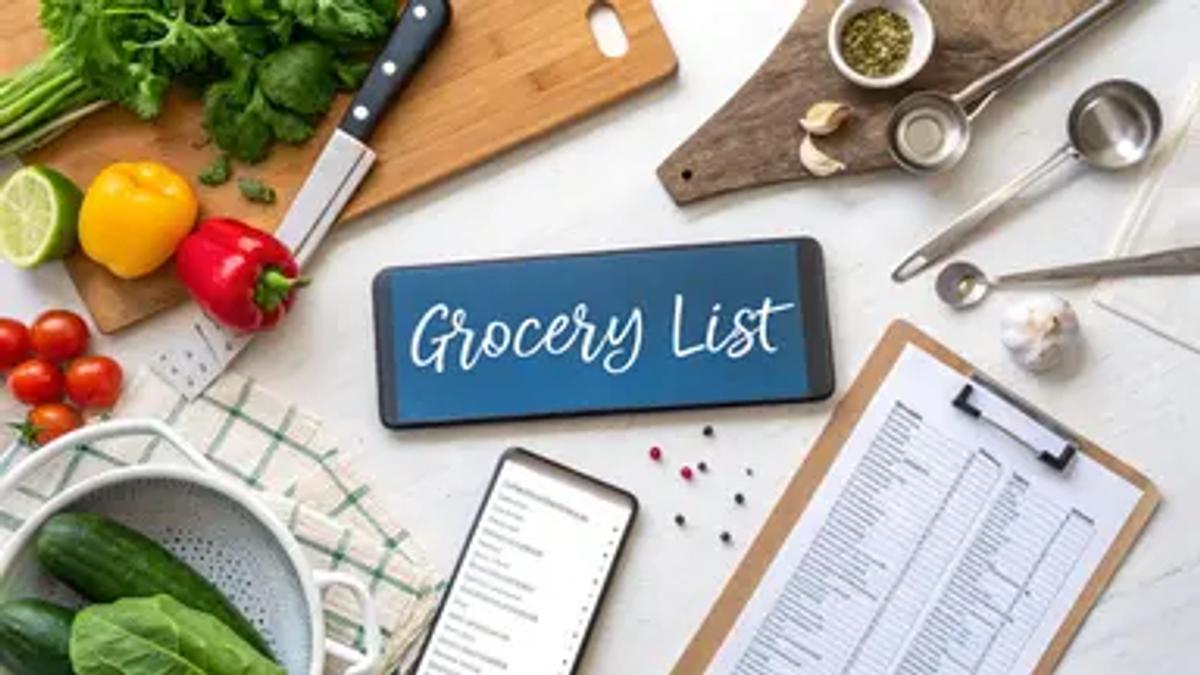
Make Grocery List From Recipes: Your Complete Digital Guide
Why Recipe-Based Lists Transform Your Kitchen Game
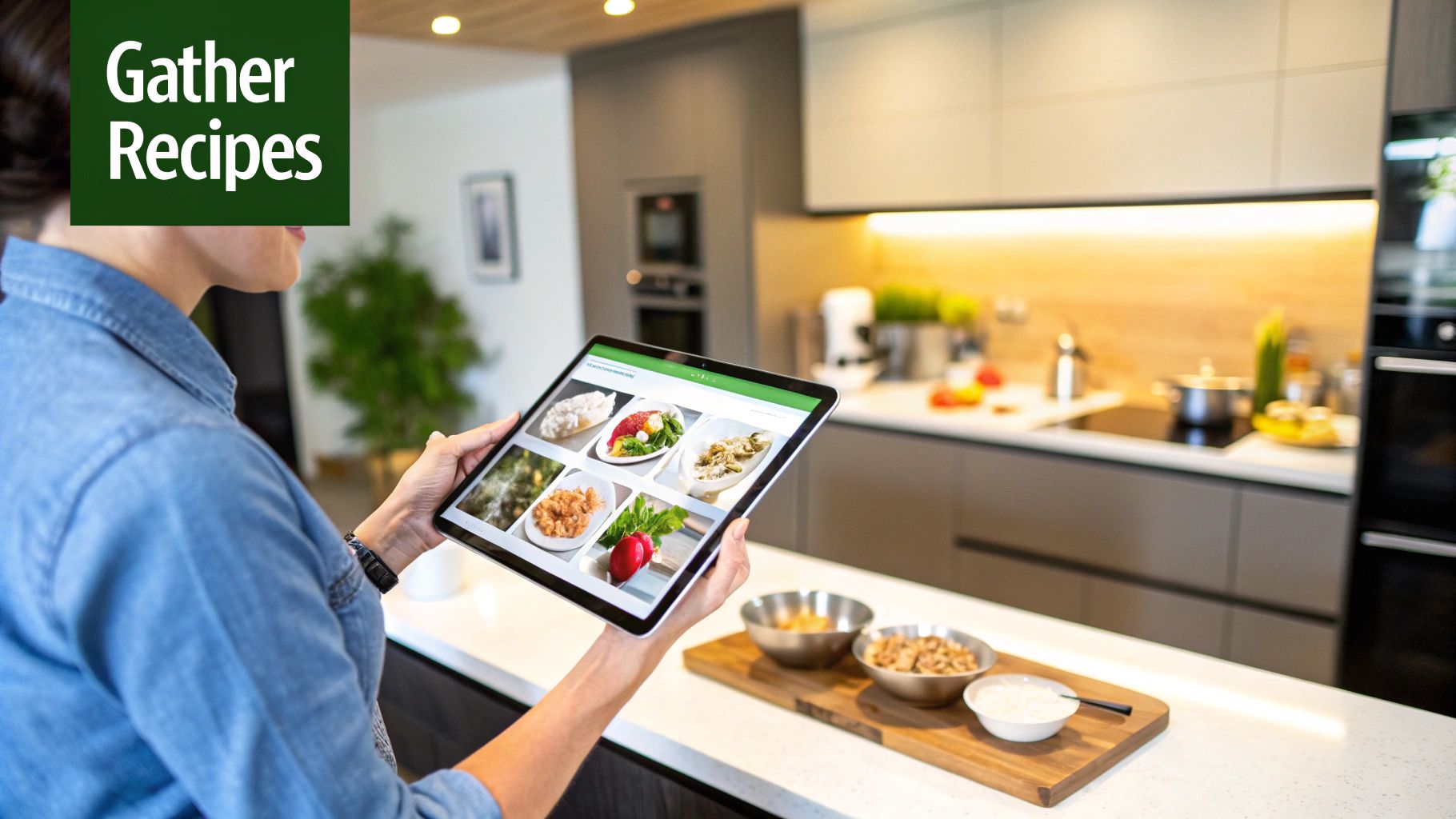
Let's be honest, grocery shopping can sometimes feel like navigating a culinary maze. Wandering the aisles often leads to impulse buys and a fridge full of forgotten food. But what if there was a better way? Enter the recipe-based grocery list – a true kitchen game-changer! This simple shift offers a structured approach to shopping, ensuring you only buy what you need for your planned meals.
Reducing Food Waste and Saving Money
One of the biggest perks of recipe-based lists is the significant reduction in food waste. Think about it: you're only buying ingredients you'll actually use. Studies show that meal planning, a key element of this approach, can slash food waste by a whopping 40%. That means less food rotting in the fridge and more money staying in your wallet. It's a win-win!
Streamlining Your Shopping Trips
Forget aimless wandering! With a recipe-based list, your shopping trips become a breeze. You'll zip through the store, grabbing only what's on your list and avoiding those tempting impulse buys. This is a lifesaver for busy folks who value convenience and efficiency. No more last-minute dinner scrambles – your meals are pre-planned and your shopping list is ready to roll.
Embracing the Digital Age of Grocery Shopping
This move towards planned purchasing is reflected in the rise of online grocery shopping, many of which now offer recipe-to-grocery-list features. Globally, online edible grocery sales jumped from $174 billion in 2021 to a projected $275 billion by 2026. That's a compound annual growth rate (CAGR) of about 9%! Find more detailed statistics here. This trend speaks volumes about the growing popularity and ease of integrating recipes into our shopping routines. Ultimately, making grocery lists from recipes not only saves you money and reduces waste but also puts you in control of your kitchen, leading to a more organized and enjoyable cooking experience.
Mastering Paper-Based Recipe List Creation
While the digital age offers countless apps and programs for meal planning, there's something satisfying about going old-school. Mastering a paper-based recipe list gives you a tangible connection to your food and a surprisingly efficient way to manage your kitchen. Think of it as a culinary adventure, starting with a pen and paper!
Organizing Your Recipe Collection
Before you even think about groceries, get those recipes in order. A chaotic pile of clippings and scribbled notes just won't do. A simple binder or some folders categorized by meal type, cuisine, or even season will transform your recipe collection into a well-oiled machine. No more frantic searches for that killer lasagna recipe hiding under a mountain of takeout menus! This simple step saves time and stress.
Extracting Ingredients and Adjusting Serving Sizes
Now for the detective work! Once you've chosen your culinary masterpieces for the week, carefully list the ingredients for each. Pay close attention to those serving sizes. If the recipe feeds four but your hungry crew consists of six, adjust those quantities accordingly. This prevents both the dreaded overbuying (hello, overflowing pantry!) and the equally frustrating underbuying (mid-recipe grocery store run, anyone?).
Categorizing by Store Layout
Think of your grocery store as a battlefield, and your list is your strategic plan. Organize your list according to the store layout. Group produce, dairy, pantry items, and frozen foods together. This targeted approach minimizes wandering aimlessly through aisles and maximizes efficiency. You’ll be in and out like a seasoned pro.
Dealing with Partial Pantry Items and Substitutions
Before you charge into battle, take stock of your existing supplies. Check your pantry and fridge for items you already have. This not only prevents duplicate purchases but also helps you refine your list. Need a cup of flour but only have half? Just note to buy the remaining half. And speaking of substitutions, always have a backup plan. If your favorite brand of olive oil isn't in stock, having an alternative listed prevents decision paralysis in the aisle.
Creating Backup Plans and Adapting to Changes
Let's face it, sometimes even the best-laid plans go awry. That's why backup plans are essential. If fresh produce isn't looking its best, having frozen alternatives on your list keeps your meal plan on track. This flexibility allows you to adapt to unexpected situations without throwing your entire week into culinary chaos. Embrace the unexpected, and your paper-based system will become your secret weapon for a smooth and stress-free kitchen.
Digital Tools That Actually Deliver Results
Switching from scribbled shopping lists to a digital grocery list might seem like a big leap, but trust me, the right tools can make the process surprisingly smooth. Today's recipe apps go way beyond just making lists – they're your secret weapon for streamlined meal planning and lightning-fast grocery shopping. Think less time wandering the aisles and more time enjoying delicious home-cooked meals!
Key Features To Look For
Not all recipe apps are created equal. Some are basic list-makers, while others are practically personal chefs in your pocket. Here’s what to look for when choosing a digital tool to make a grocery list from recipes:
- Auto-List Generation: No more manually typing ingredients! This feature magically pulls everything you need directly from your chosen recipes and compiles it into one convenient shopping list. Say goodbye to forgotten items and hello to effortless grocery shopping.
- Ingredient Consolidation: Smart apps will combine duplicate ingredients. Two recipes call for onions? Your list will show one entry for onions with the total quantity needed. Genius!
- Measurement Conversion: Scaling a recipe up or down is a breeze with apps that automatically adjust ingredient quantities. No more mental math or frantic Googling!
- Store Integration: Imagine creating your grocery list and then ordering everything directly through Instacart with just a few taps. That's the power of store integration!
- Dietary Filters and Preferences: Catering to special diets? Find an app that lets you filter recipes and generate lists that match your specific needs. Gluten-free, vegan, keto – you name it!
- Pantry Management: Keep track of what you already have at home with pantry management. This helps avoid buying duplicates and ensures you only get what you actually need.
Visualizing Your Grocery List
Many apps take grocery lists to the next level with visual representations of your shopping needs. Check out this example:
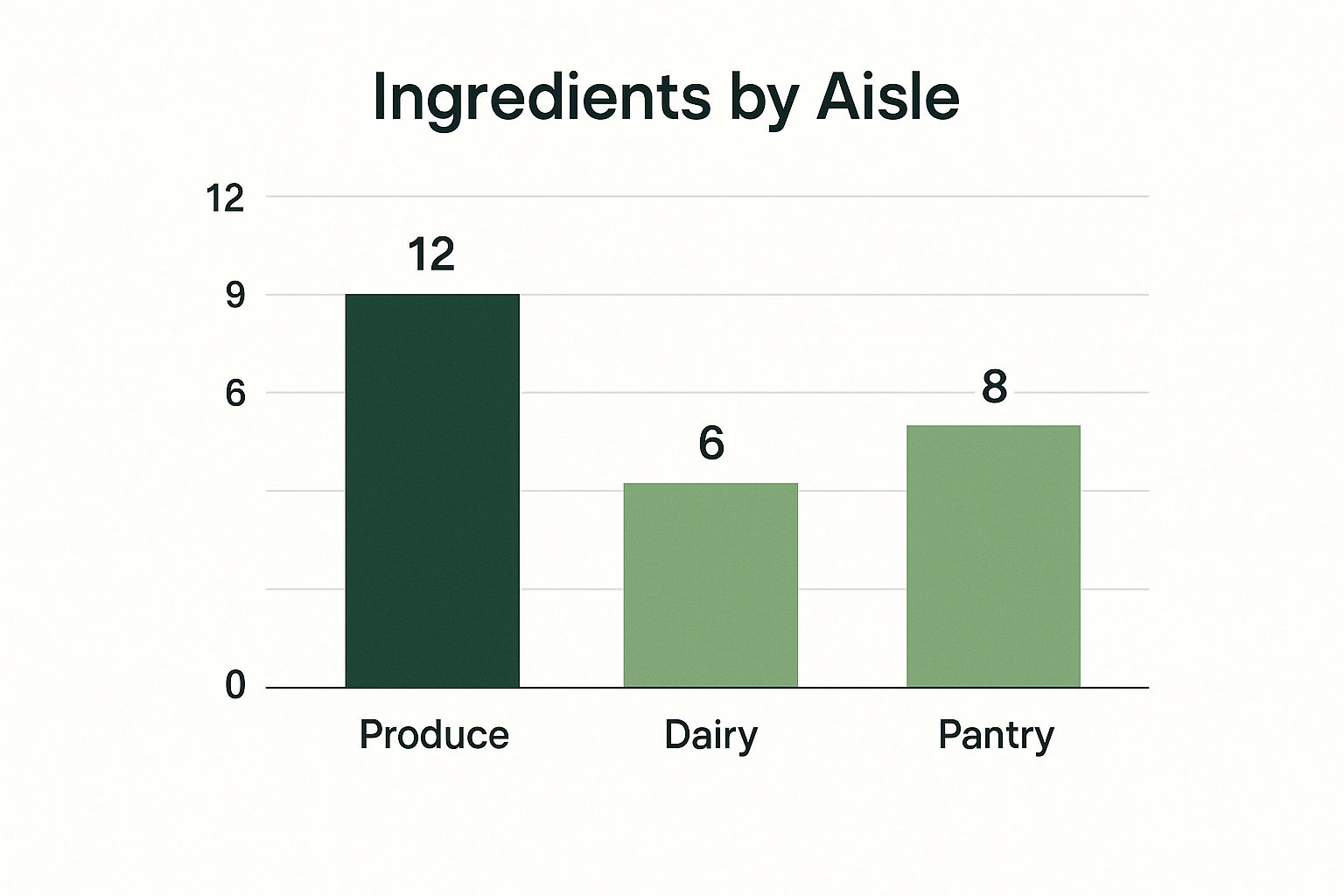
Seeing exactly what you need from each aisle – 12 produce items, 6 dairy, and 8 pantry staples – lets you plan your shopping route like a pro. This organized approach will seriously cut down your shopping time. And the proof is in the pudding (or the app downloads!): the global recipe app market, which includes these handy grocery list generators, is booming. In 2024, it was valued at $724.4 million, and it's projected to hit a whopping $2.27 billion by 2033, with a CAGR of 13.5%. Want to learn more about this growing market? Check this out.
Choosing The Right App For You
The best recipe app for you depends on your cooking style and what features you value most. If you love the convenience of grocery delivery, AI-powered platforms like Meal Flow AI can create personalized meal plans and automatically generate Instacart shopping lists. Other popular apps focus on specific dietary needs or offer advanced pantry management tools.
To help you make the best choice, let's take a look at some popular options:
Top Recipe Apps for Grocery List Generation:
Comparison of popular recipe apps and their grocery list features, pricing, and key capabilities.
| App Name | Auto-List Generation | Store Integration | Price | Best For |
| Meal Flow AI | Yes | Instacart | Varies | Personalized meal plans & automated grocery delivery |
| Paprika | Yes | No | One-time purchase | Recipe organization and meal planning |
| AnyList | Yes | No | Free/Subscription | Collaborative shopping lists and meal planning |
| Whisk | Yes | Multiple stores | Free | Recipe discovery and automatic list creation |
| BigOven | Yes | No | Free/Subscription | Recipe management and pantry tracking |
As you can see, there's an app for everyone! Exploring these different options will help you find the perfect digital tool to revolutionize your grocery list game.
Advanced Personalization Strategies That Work
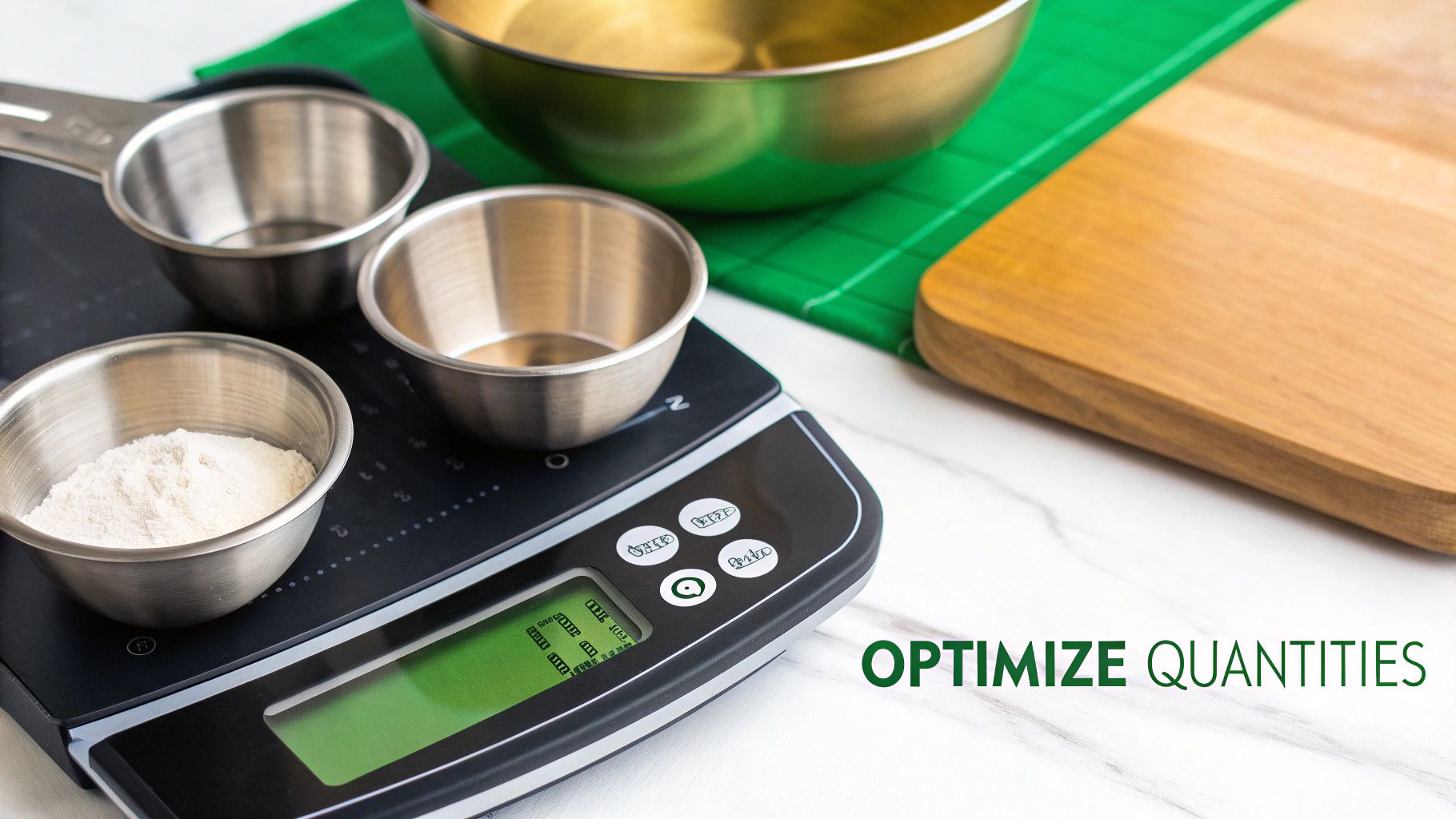
Creating a grocery list from recipes is a fantastic first step, but real kitchen magic happens with personalization. Think of your grocery list like a bespoke suit: perfectly tailored to your unique measurements and style. This takes your system from simply functional to truly exceptional.
Dietary Needs and Preferences
First up, let’s talk dietary needs. Are you gluten-free, vegetarian, or rocking the keto lifestyle? Make sure your recipes jive with these needs and tweak the ingredient lists as needed. Imagine a recipe calls for regular pasta, but you're gluten-free. Swap it out for a gluten-free option on your list, and avoid those frustrating last-minute recipe changes. And don't forget family preferences! Does your partner despise mushrooms? Off the list they go, even if the recipe calls for them.
Budget and Pantry Management
Next, budget – the ever-present factor. Building your grocery list from recipes already helps manage spending by curbing those impulse buys. But you can take it further! Plan meals around budget-friendly ingredients and give your pantry a quick scan before hitting the store. This prevents buying duplicates and lets you build meals around what you already have. A game-changer for larger families or those watching their wallets. Got half a bag of lentils? Find some lentil-centric recipes and minimize waste while saving money.
Seasonal Ingredients and Bulk Buying
Now, let’s get seasonal! Seasonal ingredients not only taste better but are often easier on the wallet. Incorporating them into your recipe selection can significantly reduce grocery costs and encourage you to explore new dishes throughout the year. And while we’re at it, consider bulk buying staples like rice, beans, or frozen fruits. Big savings over time, especially for everyday items. Just make sure you have the storage space to prevent spoilage.
Special Occasions and Picky Eaters
Special occasions add a whole new dimension to personalization. Hosting a holiday feast or having friends over? Include these events in your meal planning and create separate grocery lists for them. This streamlines shopping for larger gatherings and ensures you have every ingredient. Finally, let's tackle the picky eaters. If you’ve got kids or family members with specific tastes, find ways to incorporate their favorites while keeping things nutritious and varied.
This attention to detail is the hallmark of efficient meal planning. In fact, personalization is driving innovation in the recipe app market. The global market is projected to hit $2.32 billion by 2029, growing at a CAGR of 13.2%. This growth is fueled by advancements in artificial intelligence, which allow apps to offer personalized recipe recommendations and optimized grocery lists. Find more detailed stats here. By embracing these advanced personalization strategies, you transform creating a grocery list from recipes into a powerhouse tool for a more organized, enjoyable, and cost-effective cooking experience.
Solving Common Problems Before They Ruin Your Plans
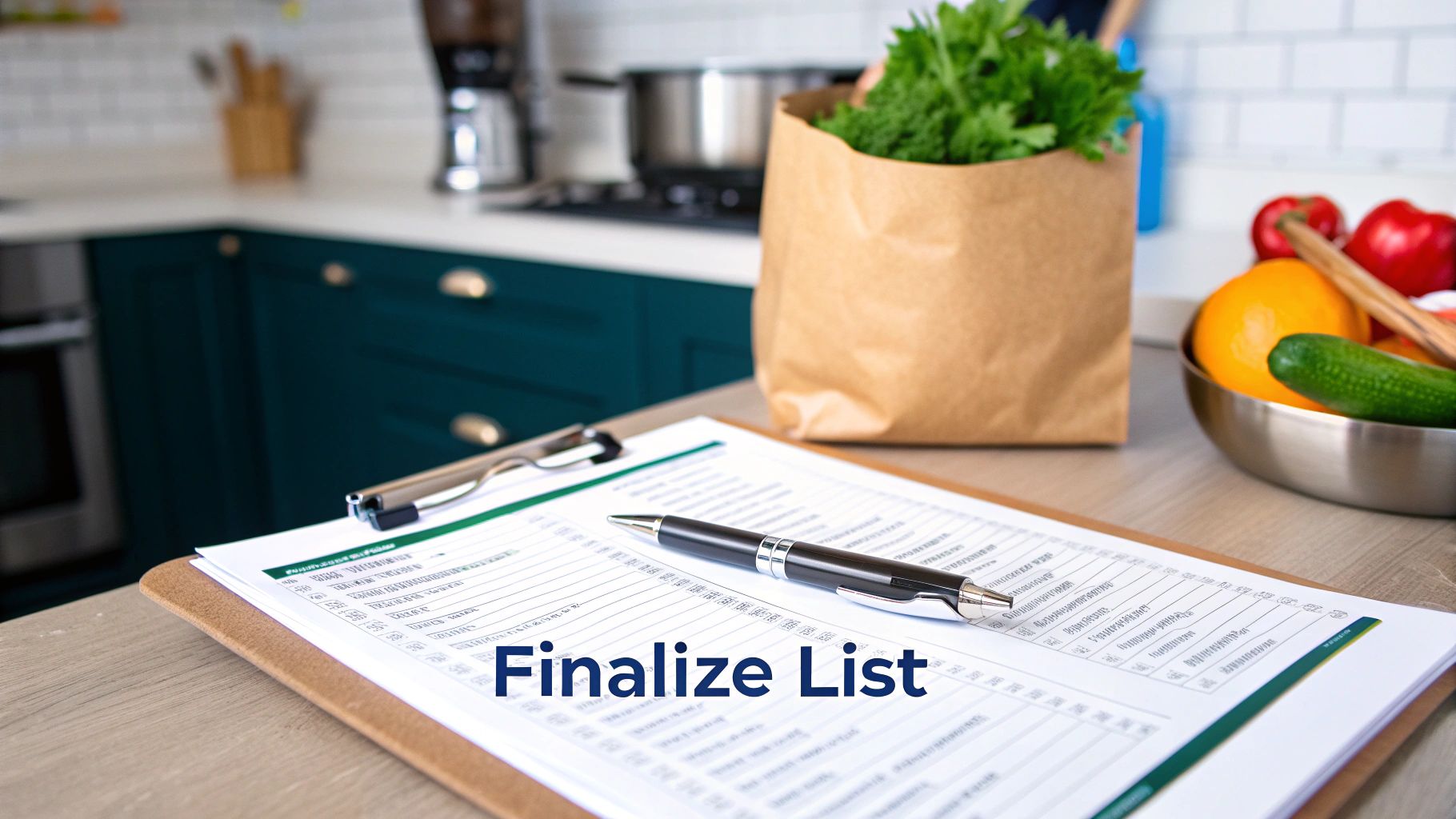
Even the best-laid grocery lists can go awry. This section dives into those frustrating roadblocks and gives you practical solutions to navigate them like a kitchen ninja.
Deciphering Ingredient Measurements and Handling Incomplete Information
Ever squinted at a recipe calling for a "smidgen" of something? Vague measurements like "a pinch of salt" or "a handful of spinach" can lead to culinary chaos. One person's "pinch" could be another's tablespoon! And what about those recipes that skip crucial steps? Don't panic!
Reliable resources or trusted cooking communities are your secret weapon. Having a go-to source to decode measurements or fill in recipe gaps can save you time and prevent kitchen catastrophes. Think of it as your culinary lifeline.
Managing Substitutions and Scaling Recipes
So, the store is out of key ingredients? Don't despair! Knowing how to substitute is essential. Out of fresh basil? Dried basil will do the trick, just use less because of its concentrated flavor.
Scaling recipes can also be a headache. Doubling or halving ingredients can lead to math mayhem, especially with fractions. Thankfully, apps and online tools like Meal Flow AI offer automatic scaling. This simplifies adjusting recipes for different family sizes or meal prepping.
Troubleshooting App Glitches and System Failures
Technology is amazing...until it isn't. App glitches can lead to lost recipes, incorrect lists, or syncing issues. Imagine your meticulously crafted list vanishing right before your shopping trip!
Relying solely on digital tools leaves you vulnerable. A backup plan, like printing your list or having a few trusty paper recipes, can prevent tech troubles from derailing your meal plans completely.
Recovering From Meal Planning Disasters
Even the best-laid plans can crumble. Unexpected events, schedule changes, or ingredient shortages can throw a wrench in the works. This is where flexibility becomes your superpower.
Experienced meal planners suggest having a few quick "emergency meals." These are your go-to dishes requiring minimal ingredients and prep time – perfect for when your elaborate meal plan goes sideways. A well-stocked pantry with staples like rice, beans, pasta, and canned tomatoes also allows for culinary improvisation.
By understanding these common challenges and using these strategies, you can confidently create grocery lists from recipes and handle those inevitable bumps in the road. Remember, flexibility and resourcefulness are key ingredients to successful meal planning.
Time-Saving Strategies From Meal Planning Experts
Tired of meal planning feeling like a second job? Want to spend less time wrestling with recipes and grocery lists and more time, well, living? These insider strategies from seasoned home cooks will transform your kitchen chaos into a well-oiled, time-saving machine.
Batch Processing Your Grocery Lists
Forget scrambling for dinner ideas every week. Batch processing your grocery lists is a game-changer. Set aside a few hours to plan several weeks of meals at once. This lets you create one comprehensive grocery list covering everything you'll need. Think of the time you'll save—and the decision fatigue you'll avoid!
Organizing Your Recipe Collection for Efficiency
Just like a well-organized closet makes getting dressed a breeze, a structured recipe system streamlines meal planning. Whether you prefer digital folders or a trusty binder, categorize your recipes. By meal type, cuisine, or even season – whatever works for you. Finding the perfect recipe becomes a snap.
Coordinating Shopping Trips With Meal Prep
Strategic timing is key. If your big meal prep day is Sunday, shop on Saturday. Put ingredients away immediately and seamlessly transition into prepping. Some families even combine grocery shopping with a monthly freezer stocking session. Pre-made meals for busy weeknights? Genius!
Seasonal Planning and Budget Optimization
Eating seasonally isn't just trendy, it's smart. Seasonal produce is usually cheaper and tastier. Plus, vibrant flavors can inspire exciting new dishes. Incorporate budget optimization techniques too. Plan meals around less expensive proteins or get creative with leftovers. Delicious food doesn't have to break the bank.
Involving the Family in the Planning Process
Turn meal planning into a family affair! Everyone gets a say, from choosing recipes to creating the grocery list. This fosters a sense of ownership and minimizes dinnertime drama. Bonus: kids are more likely to try new foods if they picked them. It's a life skills lesson and quality family time rolled into one.
Implementation and Measurement
Start small. Try batch processing for just two weeks. Once you're comfortable, gradually extend your planning horizon. Track your progress. How much time are you saving? Are you wasting less food? This data helps you refine your system and celebrate your wins.
To help you visualize this, let's look at a sample weekly timeline:
Weekly Meal Planning Timeline: Optimal schedule for recipe selection, grocery list creation, shopping, and meal prep activities
| Day | Activity | Time Required | Key Tips |
| Saturday | Plan meals for the following week | 30 minutes | Involve family members in recipe selection. |
| Saturday | Create grocery list based on chosen recipes | 15 minutes | Check pantry for existing ingredients. |
| Sunday | Grocery shopping | 1 hour | Shop during off-peak hours for a less crowded experience. |
| Sunday | Meal prep (optional) | 2 hours | Wash, chop, and portion ingredients for quicker weeknight cooking. |
This table provides a framework for organizing your meal planning activities, maximizing efficiency. Remember to adjust the time required based on your individual needs and preferences.
By implementing these time-saving strategies, you can transform meal planning from a chore into a strategic tool. Eat healthier, save money, and reclaim precious time. Take control of your kitchen and experience the freedom of a truly efficient meal planning system. And if you're looking for an extra boost, check out Meal Flow AI. Its intelligent automation generates personalized meal plans and creates Instacart shopping lists, making meal planning even easier!